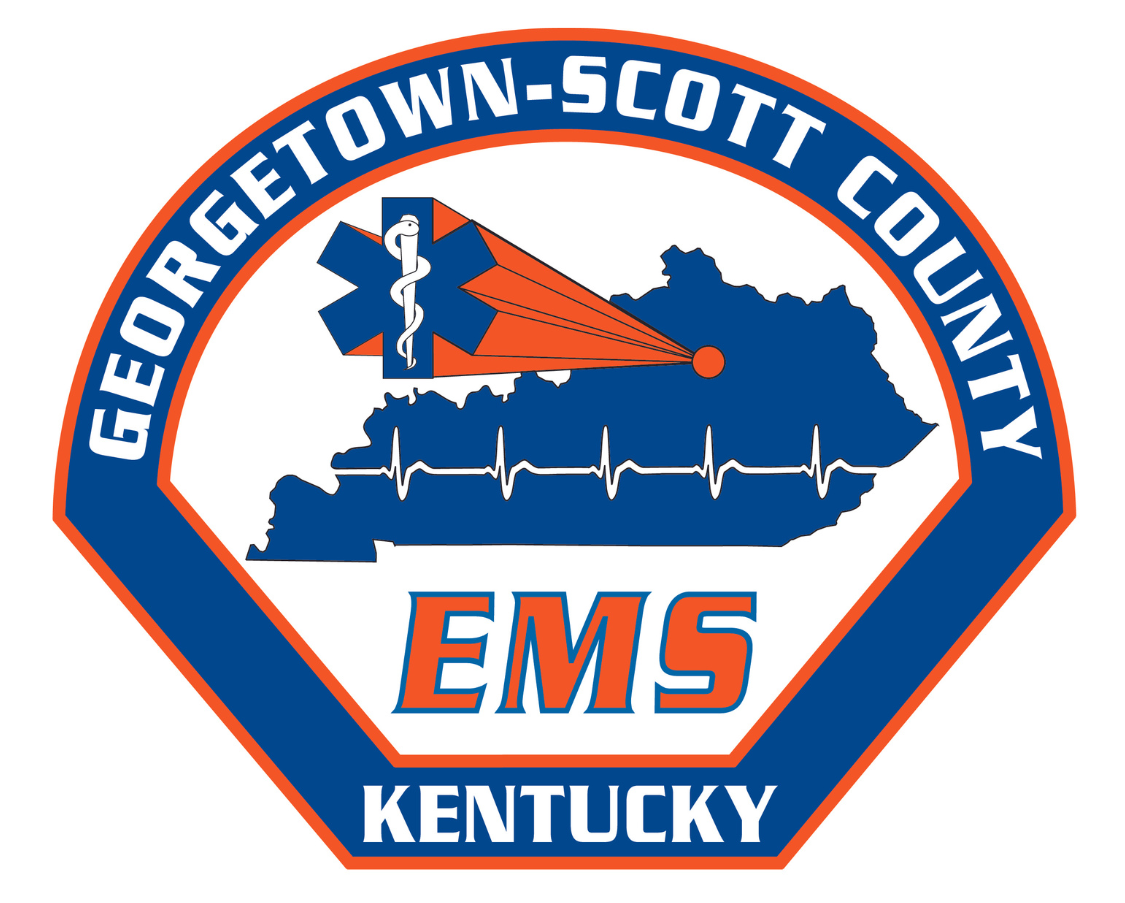Georgetown-Scott County Emergency Medical Services (GSCEMS) is Scott County’s only Kentucky Board of Emergency Medical Services (KBEMS) Advanced Life Support (ALS) certified ground transport provider. GSCEMS provides emergent and non-emergent transportation to the residents and visitors of Scott County. GSCEMS serves a population of over 50,000 residents and visitors year-round, responding to over 9,000 calls for service annually. We currently operate six (6) ALS ambulances and one chase (supervisor) vehicle, responding from four (4) stations located throughout the county. Our stations include one in downtown Georgetown, one within the city/county limits area, one in Stamping Ground, and one in Sadieville.
Our Mission
Committed to service, guided by compassion, and defined by excellence, we deliver exceptional prehospital care with integrity and professionalism. Through evidence-based practice, operational expertise, and continuous education, we strive to set the standard for EMS — one patient at a time. With unwavering dedication to those we serve, our mission is not to follow best practices, but to define them.
GSCEMS History

On April 15, 1976, the Scott County Fiscal Court and the Georgetown City Council agreed to create what is now known as Georgetown-Scott County Emergency Medical Services. This was the first joint emergency service in Scott County. Under the direction of Charles Southworth, the service worked with one BLS (Basic Life Support) crew from 6:00 a.m. until shift change the next morning at 6:00 a.m., who were paid on a per-run basis. Under the direction of the late Warren Powers, the crews began working 24-hour shifts with 48 hours off, a schedule similar to that of the fire department. Our run volume averaged about 1,200 runs per year.

In September of 1989, under the direction of Howard Bennett EMT-P, Georgetown-Scott County EMS was approved by the state to upgrade to ALS (Advanced Life Support). This allowed our service to employ paramedics who were authorized to administer IV (intravenous) fluids and medications, as well as perform EKG monitoring, cardiac defibrillation, advanced airway maneuvers, and other advanced skills.
Today, we average over 9,000 calls per year utilizing some of the newest technology available for pre-hospital care. We have nine ambulances and a full-time paid staff of 55 employees. This includes a director, two assistant directors, two education coordinators, 35 Paramedics, 3 Advanced Emergency Medical Technicians (AEMT), and 12 Emergency Medical Technicians (EMT). For additional assistance, we call upon our pool of part-time personnel.
As of January 1, 2019, our service is officially governed by the Scott County Fiscal Court with Judge-Executive Joe Covington.
As of September 2020, our EMS Chief is Chris Runyon, NRP.
Our crews operate on a 24/48 rotating schedule. This means the crews work for 24 hours and enjoy 48 hours off. This leads us to have three (3) separate platoons or shift days. Each platoon has enough staff to run six (6) ALS ambulances with one supervisor who operates the chase vehicle.

McKayla Brandenburg, First Platoon Battalion Chief
I have been a paramedic for five years and have worked in EMS for six years overall. I hold a bachelor’s degree in Emergency Medical Care with a concentration in Administration from Eastern Kentucky University, and I currently serve as the lead educator for our EMT program at GSCEMS. To me, being a Battalion Chief means embodying leadership through guidance, support, and accountability. It’s about being a resource and a sounding board for my crews, ensuring that each day runs smoothly, efficiently, and with purpose. Above all, it means fostering professionalism and excellence while creating an environment where every team member can perform at their best.

Joseph Mata, Paramedic, Second Platoon Battalion Chief
Being a Battalion Chief at Georgetown-Scott County EMS means I have the privilege of working alongside some of the best providers in the state. I’m honored to help develop some of the brightest minds in our industry; fostering growth, recognizing potential, and guiding our paramedics and EMTs as they advance in their careers. This role is about providing strong, steady leadership in the field and serving as a role model for future leaders. We set the tone for the organization by cultivating a culture built on professionalism, integrity, and service. As Battalion Chiefs, we ensure our platoons are prepared for operational readiness. We anticipate challenges, manage resources efficiently, and make critical decisions in real time to keep our crews and community safe. At its core, this position is about service, leading with purpose, supporting our teams, and upholding the standard of excellence that defines GSCEMS.

Leland Robinson, Paramedic, Third Platoon Battalion Chief
Being Third Platoon Battalion Chief (The Dirty Thirds) requires much more than just overseeing daily operations. A Battalion Chief should be selfless or altruistic in nature. As a line Medic, AEMT, or EMT, it is you and your partner treating patients and doing the task asked. One big transition I quickly learned when I became Battalion Chief is that it no longer just my partner and I. I am essentially responsible for 12 individuals. The only way I see a Battalion Chief being there for 12 staff members is by trying to put them first. I was once told; a great Battalion Chief should be the hardest one working on shift if they’re doing it right. I’ve tried to instill that mindset into every shift. May require some sacrificing but shows leadership. To me, working hard and selflessness is what being a Battalion Chief means to me and everything else comes easy.

Our ongoing mission at GSCEMS is to endeavor to become the preeminent Pre-hospital Health Care Provider in Central Kentucky by pledging to be an advocate for our customers and our community. We are committed to serve through our devotion to education by creating a culture of accountability in an atmosphere of integrity.
Stay Connected With Us!
